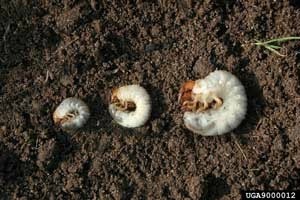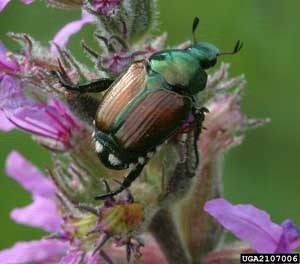Identification
Look for metallic blue-green, long-legged beetles with coppery-colored wing covers. Adults lay eggs from June through August. Eggs hatch into fat white, comma-shaped grubs with brownish-orange heads. Grubs overwinter in the soil and pupate in June.
Favorite Plants
Adult beetles will eat most garden crops and grubs feed on grass
Damage
Adult beetles eat flowers and strip off the leaves of plants. Like all white grubs, Japanese beetle grubs prefer to feed on the tender roots of grass. Lawns develop large areas of dead brown grass that will peel back like a rug when pulled.
Organic Methods of Control:
Cultural or Mechanical
- Shake beetles onto tarps placed beneath plants in the early morning.
- Hand pick beetles from plants.
- Cover plants with floating row covers or screens.
- Interplant garlic, larkspur, tansy, rue and geranium.
- Use spiked sandals on lawns to kill grubs as they feed near the surface in the late spring.
- Kill eggs by allowing lawn to dry out between watering and allowing it to go dormant in the summer.
Biological

Japanese Beetle Grub. Photo by David Cappaert (
www.insectimages.org)
- Apply parasitic nematodes as a top dressing to plants and lawn in spring.
- Apply milky spore disease (Bacillus popilliae) to grassy areas.
- Attract birds to your yard and garden.
Chemical
- Spray a mixture of garlic, onion and pepper to deter adult beetles from feeding on plants.
- Spray soap and lime directly onto adult beetles to irritate them.
- As a last resort, spray beetles with pyrethrins or rotenone.

